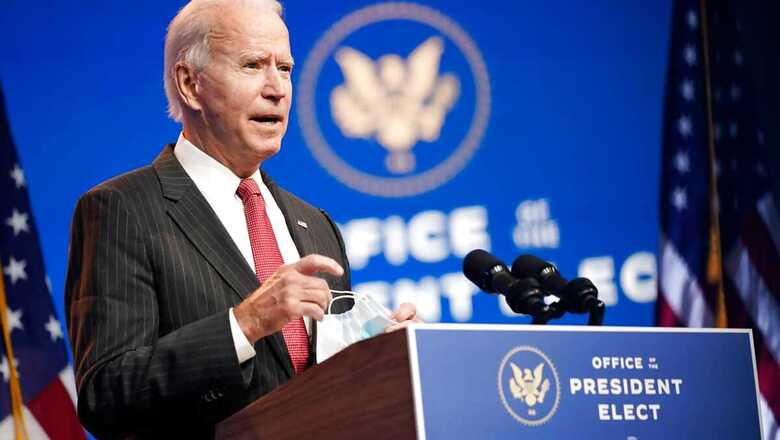
views
Joe Biden is not the first US president to face a growing number of migrants at the US-Mexico border — and he won’t be the last. Fluctuations in migration flows are common, regardless of which party is in power, as was evident in 2019 during the border crisis under then-President Donald Trump.
It’s difficult to compare today’s situation with those of recent years because of the drastically different circumstances, in part relating to the pandemic. There are several factors at play — including deteriorating conditions in Latin America, pent-up demand to enter the US and a perceived relaxation of enforcement under Biden — that are driving migrants to the border at what appears to be an accelerated pace.
All of that could set 2021 on track to exceed 2019 in the number of people apprehended at the border. Just over 100,000 people were encountered last month, 24,000 more than in February 2019.
And the number of unaccompanied children crossing the US-Mexico border in March is on pace to surpass May 2019, the highest month that year in arrests of minors, according to preliminary data reviewed by CNN.
Here’s what to know about the situation at the border:
Is the border open?
Not quite. The Biden administration is leaning on a public health law invoked by the Trump administration to quickly expel migrants who are encountered at the US-Mexico border, typically single adults and some families.
In February, for example, the majority of migrants encountered at the US-Mexico border were immediately turned back — and some of those tried to cross again. Numbers had started to steadily climb last summer.
Of the nearly 97,000 migrants who crossed the border illegally in February, around 70,100 were turned away, according to US Customs and Border Protection data. Those numbers may reflect some repeat crossers. If not for that Trump-era policy, they would generally be processed and come into US custody.
That is similar to how the border was operating over the last year under Trump, except for one difference — unaccompanied migrant children aren’t being expelled.
The Biden administration, in the case of children, reverted to the process as it was pre-pandemic — accepting unaccompanied children into the US and transferring them to the custody of the Department of Health and Human Services, which is charged with their care.
“With kids we’re seeing something unique that is larger than what we’ve seen before,” said Andrew Selee, president of the Migration Policy Institute, a nonpartisan think tank. “With adults we’re also seeing larger numbers than we have in recent years, but they’re not getting in.”
When was the last border crisis and how bad was it?
In 2019, the Trump administration faced high numbers of families and children coming to the US southern border. During the 2019 fiscal year, the Border Patrol arrested more than 473,000 migrant families and around 76,000 unaccompanied migrant children.
The flow of migrants overwhelmed government resources, resulting in overcrowding at Border Patrol facilities and in some cases, children seen sleeping on the floor.
May 2019 saw the highest number of overall apprehensions: 144,000.
How does 2019 compare with 2021 for children?
As far as unaccompanied minors, the number of children arrested at the border in March will likely easily surpass the high during May 2019, when around 11,400 unaccompanied children were arrested, according to preliminary government data CNN has reviewed.
The trend is unmistakable. In February, more than 9,200 unaccompanied children were arrested by US Border Patrol on the US-Mexico border, up from 5,694 in January, according to the latest available CBP statistics.
In May 2019, at the height of that crisis, 11,475 unaccompanied kids were arrested by US Border Patrol. In February of that year, 6,817 unaccompanied children had been arrested.
We’re still early in the year, which is why the accelerated pace of arrests is so concerning. Seasonal trends tell us numbers go up in the spring and summer.
How does 2019 compare with 2021 for adults and families?
As far as families, the numbers this year are not what they were in 2019, but that could climb.
“I would’ve said two weeks ago that this was nothing like 2019. The fact now that a high percentage of families are being admitted means that it’s likely we’ll see an exponential increase of families getting across,” Selee said.
Families from Mexico and the Northern Triangle countries are sent back to Mexico unless Mexico does not have the capacity to receive them, the Department of Homeland Security said in a statement this month. In other words, if Mexico won’t take them, they’re processed into the US.
That shift can travel via word of mouth and result in more families at the border.
Why are people coming to the US?
The pandemic has taken a dramatic toll on Latin America, where Covid-19 cases and deaths have soared and economies once projected to grow have been decimated. The region was also hit with two devastating hurricanes. The decline in economic growth in 2020, according to the Congressional Research Service, is expected to worsen income inequality and poverty in the region.
That, combined with pent-up demands and the perception of the Biden administration being more lenient, has fuelled migration.
Trump-era policies barring people from coming to the US also contributed to more people waiting in Mexico to come to the United States.
In addition to turning away migrants during the pandemic, the Trump administration had pushed non-Mexican asylum seekers to Mexico until their court dates in the United States, leaving tens of thousands languishing in poor conditions in Mexico.
“We’ve had a little over a year of (Migrant Protection Protocols), two years, and then Title 42 and that created a real anomaly in the sense that we had hundreds of thousands of people staged in Mexico ready to come: Central Americans,” said John Sandweg, a former senior Homeland Security official under the Obama administration. “I think that’s playing a big role and artificially increasing the numbers.”
Why are children, in particular, crossing alone?
There are many different reasons migrant children travel alone to the United States. CNN’s years of reporting at the border and conversations with experts reveal a common thread: It’s not a decision any family makes lightly.
Many of these children, who the government dubs “unaccompanied minors,” make asylum claims when they arrive because they’re fleeing persecution, gang violence and other forms of organized crime. Dire economic circumstances in their home countries may also contribute to their decisions to leave.
Some parents initially make the journey with their children, buoyed by misleading statements that smugglers use to entice them onto the trek. But families sometimes find themselves making different decisions once they reach northern Mexico and come to understand the realities of the border.
In 2019, for example, some parents started sending children alone across the border once they realized the US government was subjecting families to a Trump-era policy that forced them to remain in Mexico, but not kids traveling alone.
Wendy Young, president of Kids in Need of Defense, an organization that works with unaccompanied children, said some children who are crossing now had been kicked back to Mexico under Trump.
What happens after migrant children arrive?
After children are taken into Border Patrol custody, they’re turned over to the Department of Health and Human Services, which is charged with the care of migrant children.
HHS oversees an expansive shelter network where those children are placed until they can be relocated with sponsors, like a parent or other relative, in the United States. But it’s been strapped for space after operating under limited capacity as a result of the pandemic.
Over the last week, HHS has either opened or announced new facilities, equipped for kids, to start to accommodate the children crossing the US southern border, and has moved to fast-track release of some children to sponsors. There are about 11,300 children in HHS custody.
According to Homeland Security, in more than 80% of cases, the child has a family member in the United States. Once they’re reunited, children continue with their immigration proceedings, in which an immigration judge ultimately decides if they can remain in the country.
Read all the Latest News, Breaking News and Coronavirus News here




















Comments
0 comment